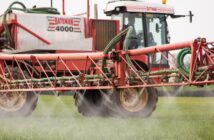Listeners of BASF’s latest podcast, ‘Strong against weeds together’, hear industry-leaders discuss their hopes and fears around weed control, IPM and resistance management.
Cereal herbicide campaign manager at BASF, Ali Richards, hosts the first episode where NIAB’s weed biology specialist John Cussans, Lincolnshire grower Daniel King and BASF’s head of technical management, Rob Gladwin, sit down for a chat in the field.
“With Brexit we’re moving into a new policy environment and I hope, for the industry, farm support will enable some the aspects we’re discussing like cultural controls, as well as public money for public goods,” says Mr Gladwin.
“More broadly, I think the industry can be hopeful for the role innovations will play. There’s currently talk of legislation around gene editing coming forward later in the year as an example, but I’m also hopeful for new innovations in the crop protection arena too.”
New technology was an emerging theme of the autumn podcast. For Mr King this includes novel approaches which are still in the early stages of development, for Mr Cussans it’s our attitudes towards innovations that are key.
“There’s machinery which combines image recognition with electric shocks to autonomously kill weeds. With issues around labour and the environment, this type of technology is very exciting,” says Mr King.
“Shorter term, we all need new molecules and new actives. I’ve been to a few trials, seen the new Luximo® and it looks very good. When it comes to controlling black-grass that will definitely be a big help. But you still can’t rely on a new chemical alone, we have been down that road before,” he warns.
Having battled black-grass for over 15 years, Mr King is well placed to discuss where there is hope and where there are challenges.
“Delayed drilling, alongside spring cropping, is one of the most effective ways of combating black-grass,” he says. “You’ve got to drill wheat from 25th October onwards to get the good flush and allow the pre-ems to work really well.”
“The success of establishing spring crops is purely down to the weather. Some years it goes well, others not so much. Resistance has meant we’re much more reliant on pre-ems.”
Taking a programme approach to pre-ems, Mr King describes how he uses four or five different actives, with Crystal® as the keystone.
“It’s important to put black-grass under as much pressure as you can while it’s small. Using high grammes of actives and timing applications when there is moisture,” he explains.
“I’ve had a lot of trials with Liberator® but Crystal® always seems to do a better job. We try to apply the liquid pre-ems as soon as possible after drilling. Then we come back with the Avadex® granules as soon as the contractor is available.”
Mr Cussans, who discusses in detail the practicalities and importance of resistance management and the role of crop suppression, hopes for a wider range of profitable spring crops and more open mindedness.
“It may seem completely divorced from weed management but being able to broaden rotations with a more diverse set of profitable spring crops would make achieving so many of our objectives much easier,” he says.
“If we’re open minded, and we look for innovations, there are always going to be opportunities to adopt practices and adapt them for different situations. And if we’ve got people who are open to change, adoption and adaptation, we get much better long term weed management outcomes.”
If you’d like to hear more visit: https://soundcloud.com/basf-ag-solutions-uk/basf-strong-against-weeds-together




